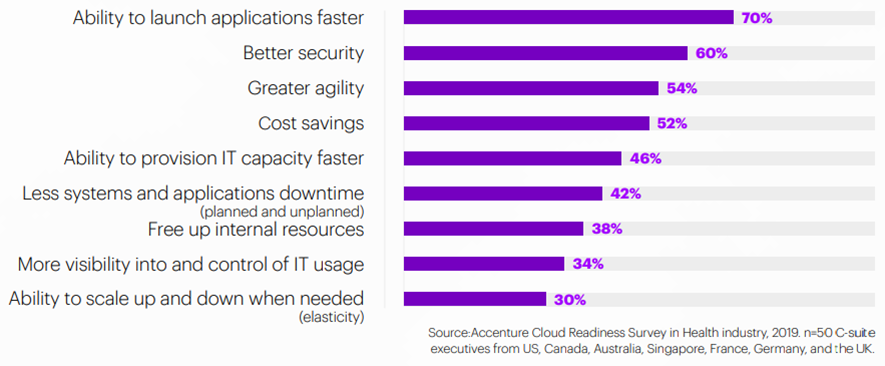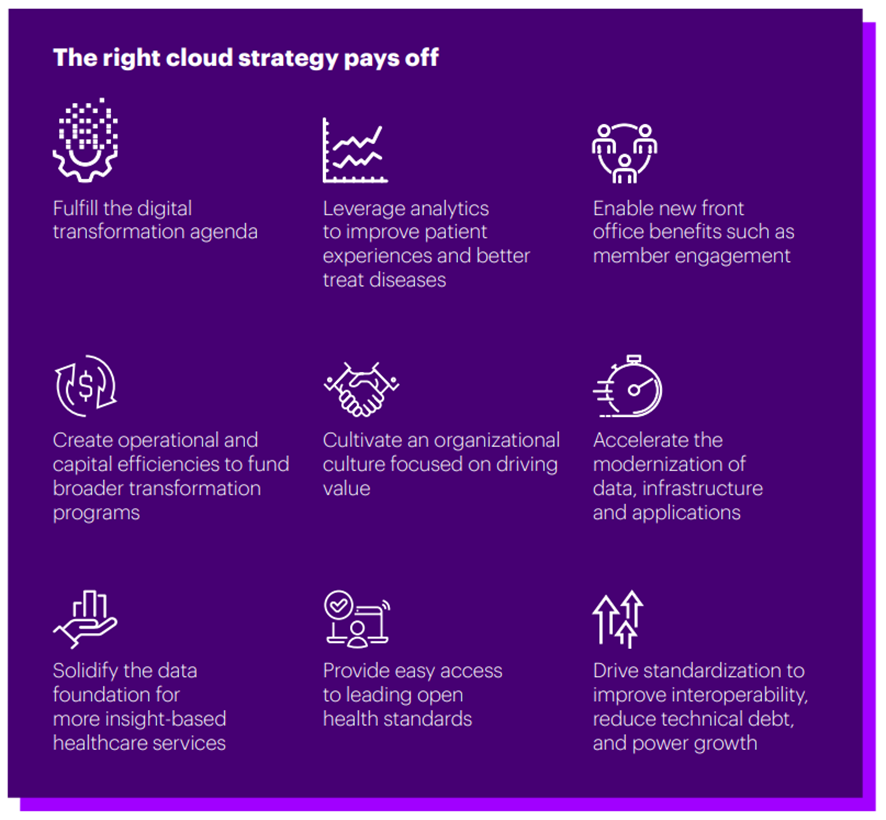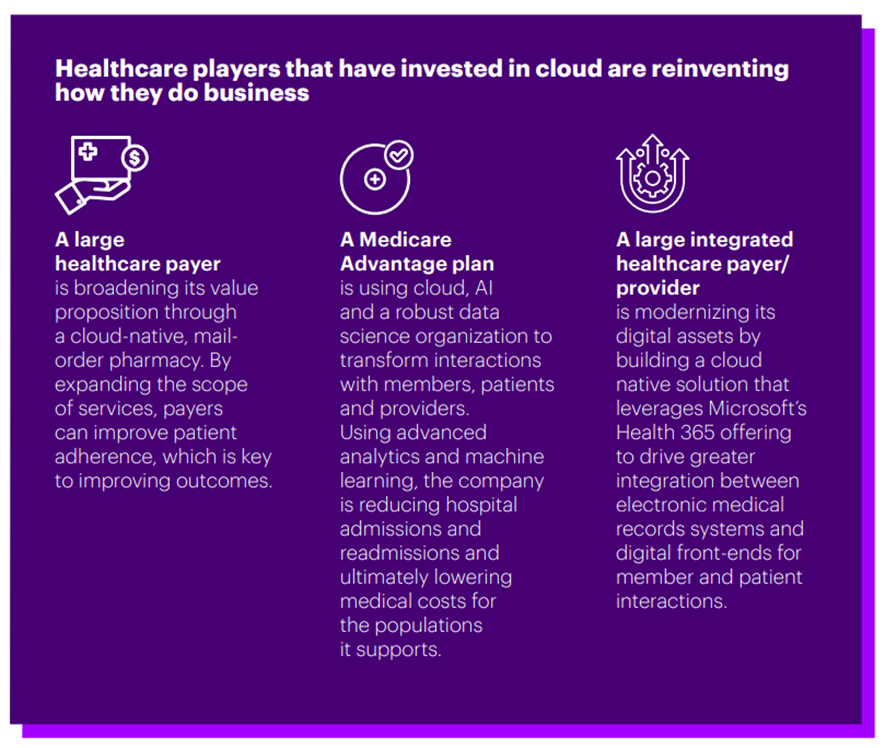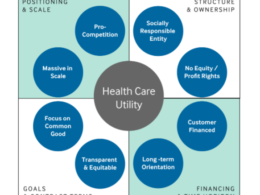This is an excerpt of the publication “The cloud imperative in healthcare”, with the title above, focusing on the topic in question. For the full version of the article, please refer to the original publication.
2021
Chris D’hondt ; Sanjay J. Mehta; Oleg Kucheryavenko, MD, MPH ;
David Wood
Executive Summary
by Joaquim Cardoso MSc.
Health Transformation — Institute
Multidisciplinary Institute for Continuous Transformation in Health and Care
June 10, 2022
Structure of the original publication
Cloud is not new in healthcare
The path forward
- Introduction
- The traditional data center approach has matured over time to include various forms of cloud
Why cloud now?
- Business leaders have a stake in cloud
- Cloud service providers are prioritizing the healthcare industry
- Public cloud unlocks new value — and reduces costs
- Public cloud is more secure by default
Moving to action
- How do we organize around cloud?
- How do we drive change quickly despite complex legacy systems and technical debt?
- How do we need to think about value to stakeholders?
Conclusion

EXCERPT 1
Cloud is not new in healthcare
Two years ago, organizations were experimenting in the public cloud.
Now their focus is on migrating legacy technology to the cloud and transforming data and applications using capabilities that aren’t available in their existing infrastructure solutions.
Forty-four percent of healthcare CIOs rank cloud services as a top-three investment priority.[1]
Yesterday, cloud was about aspiration. Today, it is about scale.
Yesterday, cloud was about aspiration. Today, it is about scale.
Two years ago, organizations were experimenting in the public cloud.
Now their focus is on migrating legacy technology to the cloud and transforming data and applications using capabilities that aren’t available in their existing infrastructure solutions.
Yet only half of healthcare organizations have mature cloud practices and tools in place.[2]
Even so, cloud is a disruptive force fueling innovation in the industry.
Healthtech players with cloud solutions continue to grow as market influencers.
In addition, the big three cloud hyperscalers in the North American market — Microsoft, Amazon and Google — have healthcare in their sights and are investing in innovation.
Cloud is not the only disruptive force in healthcare — there are many.
There is nothing quite like the impact of COVID-19. The pandemic environment exposed vulnerabilities and accelerated change. It amplified the need for resiliency and scalability. It created urgency for healthcare organizations to securely handle large volumes of patient data, and quickly migrate and modernize apps while automating IT processes to support a remote workforce and expand virtual care delivery.
Cloud is not the only disruptive force in healthcare — there are many. There is nothing quite like the impact of COVID-19
As business priorities shift, modern cloud-enabled technologies are more critical than ever in healthcare.
However, scaling cloud can be complicated.
There is internal complexity to address. There are relationships with ecosystem partners to navigate.
There are data insights to harvest to improve efficiency and patient care.
There is the weight of legacy investments to shake off. Healthcare is at a tipping point.
As business priorities shift, modern cloud-enabled technologies are more critical than ever in healthcare.
A hybrid cloud environment can solve many of its biggest challenges.
But how does a historically risk averse industry make it happen fast enough?
A hybrid cloud environment can solve many of its biggest challenges.
But how does a historically risk averse industry make it happen fast enough?
By working across the business, healthcare players can harness cloud to operate in a climate where the resilience of people, systems and partnerships is paramount.
By working across the business, healthcare players can harness cloud to operate in a climate where the resilience of people, systems and partnerships is paramount.

EXCERPT 2
Why cloud now?
Cloud is no longer a pure technology play in healthcare. It’s a business play.
Consider the four reasons why healthcare organizations should act with urgency to develop and implement their cloud strategy.
- Business leaders have a stake in cloud
- Cloud service providers are prioritizing the healthcare industry
- Public cloud unlocks new value — and reduces costs
- Public cloud is more secure by default

Business leaders have a stake in cloud
Healthcare executives most frequently cite the ability to launch applications faster, better security and greater agility as the top benefits of cloud (Figure 1).
The fact that cost topped this same list in last year’s survey reveals just how quickly healthcare executives’ views of cloud have shifted from a transactional to a strategic lens.
Figure 1: Healthcare executives are more interested in business benefits from cloud than cost benefits

Question: What benefits does your organization expect to gain from cloud?
In healthcare in particular, every C-suite leader has a vested interest in cloud and modern technologies.
They are each looking for a specific kind of new value, and a different value case resonates with each one:
CEO — Drive transformation and new business models
- CEOs look for cloud to help turn investments in operations and innovation into new revenue streams.
- This could mean partnering across the ecosystem to orchestrate the development of research and new products.
CFO — Cost transparency and better technology business management
- CFOs look to cloud to limit large capital investments and shift from Capex to Opex.
- They recognize opportunities to use shared services platforms and to reduce shadow IT, which is common in the healthcare industry.
COO — Leverage data to drive outcomes via automation
- COOs look for cloud to contribute to the integration of business strategy with operations.
- This could mean leveraging new technologies to new clinical programs to improve outcomes, and positively affect the P&L.
CIO Provide strategic value to the business
- CIOs look for cloud to help them shift their focus from hardware and software implementations and managing the physical infrastructure.
- This frees them to position themselves as strategic thinkers providing business leadership and digital innovation.
CMO Improve care delivery and clinical operations
- CMOs look for cloud to provide real-time insights and outcomes-based care.
- This could mean using data insights to reduce readmissions, improve patient flow, enable virtual health and provide seamless experiences to nurses and clinicians.
CDO Adapt to industry changes that are reshaping value
- CDOs look for cloud to accelerate time to market for new, digital capabilities.
- This could mean brokering and testing new ways of operating and innovating, launching an organization on a digital trajectory to improve experience and create data-driven products.

Cloud service providers are prioritizing the healthcare industry
It’s not only executive leadership that is taking notice of the value of cloud for healthcare. Health is the market priority of the leading cloud service providers.
Microsoft, Amazon and Google are each investing heavily in healthcare and setting up vertical platform capabilities with specific assets.
These companies are looking to partner with major players in the healthcare ecosystem, primarily through joint offerings.
The goal is to further expand and democratize their services for use beyond core IT applications.
Amazon Web Services, which had nearly one-third of market share as of the fourth quarter last year, has made several health-related acquisitions, supports over 100 HIPAA eligible services and spent upwards of $37 billion in R&D last year.[4]
The company has said it wants to give developers the tools to create apps and unlock insights across the entire enterprise.
Beyond data scientists and application developers, the company intends to enable operations, marketing, the business and executives with AI and machine learning tools that apply new types of intelligence across functional domains.[5]
This kind of disruption will require traditional healthcare players to rethink their entire organizations, including the role that technology plays outside of IT.
Amazon Web Services, which had nearly one-third of market share as of the fourth quarter last year, has made several health-related acquisitions, supports over 100 HIPAA eligible services and spent upwards of $37 billion in R&D last year
This kind of disruption will require traditional healthcare players to rethink their entire organizations, including the role that technology plays outside of IT.

Public cloud unlocks new value — and reduces costs
All of this momentum — this “buzz” from executives and cloud service providers — signals just how strong the value story is for the journey to cloud in healthcare.
Cloud is the means to the end for healthcare organizations to improve operations, clinical research and care delivery because it grounds the business in agility, collaboration and insight-based action.
Cloud is the means to the end for healthcare organizations to improve operations, clinical research and care delivery because it grounds the business in agility, collaboration and insight-based action.

These are transformational improvements for the entire healthcare ecosystem.
With the right cloud strategy and investments, payers, providers, research organizations and new market entrants can evolve their roles, value propositions, business models and partnerships to improve healthcare coordination, delivery — and outcomes.
With the right cloud strategy and investments, payers, providers, research organizations and new market entrants can evolve their roles, value propositions, business models and partnerships to improve healthcare coordination, delivery — and outcomes.
In our experience, healthcare organizations that implement a multi-cloud operating model can see a 20 to 50% expansion in productivity, a 30 to 80% jump in quality improvement and a 2 to 8x increase in speed to market.
… healthcare organizations that implement a multi-cloud operating model can see a 20 to 50% expansion in productivity, a 30 to 80% jump in quality improvement and a 2 to 8x increase in speed to market.
There is also a cost angle to the cloud value story in healthcare.
It is much less expensive to utilize public cloud capabilities than it is to use on-premise and private cloud alternatives.
Accenture experience reveals that when organizations migrate to cloud at scale and have a modern governance model, they can realize 20 to 40% savings annually.
… when organizations migrate to cloud at scale and have a modern governance model, they can realize 20 to 40% savings annually.
The economics of the cloud makes it possible for organizations to be more self-funding.
Gone are the days when health players had to spend hundreds of millions of dollars over years disrupting their business.
Now they can do it in an iterative way.
Many of our clients are using cloud savings to eliminate legacy debt and fund their digital transformations.
One financial services company realized a 29% cost reduction in product development and launch by focusing on a single application area after implementing cloud native xtreme programming capabilities.
This allowed the organization to fund an additional $20 million in new investments


Public cloud is more secure by default
Despite clear benefits, security concerns are common among healthcare organizations that have been slow to adopt cloud.
This is the case even as 40% of healthcare CIOs acknowledge that the public cloud is more secure than either private cloud or on-premise data centers.[6]
This gap between action and insight suggests that these security concerns come from misperceptions and mindsets, not from concerns about the technology itself.
In other words, apprehension is not about the “what” of the technology, it’s about the “how” of implementing it.
But here’s what every healthcare leader should know.
Public cloud is more secure by default. With public cloud, the default posture is to deny access; users and services must be explicitly granted permission to access resources.
This design significantly enhances the organization’s overall security posture.
And in addition, it is the exact opposite of inherently open on-premise environments where policies are manually applied to limit access.
Despite clear benefits, security concerns are common among healthcare organizations that have been slow to adopt cloud.
This is the case even as 40% of healthcare CIOs acknowledge that the public cloud is more secure than either private cloud or on-premise data centers
…apprehension is not about the “what” of the technology, it’s about the “how” of implementing it.
To take advantage of the security benefits of the public cloud, healthcare organizations cannot simply expect to reapply existing security practices, processes and tooling.
They must align with other stakeholders — especially the CISO — focusing on desired outcomes and refreshing security controls.
They must also be prepared to work differently with partners and public cloud providers to build and maintain security compliance in line with the nuances of healthcare and HIPAA.
To take advantage of the security benefits of the public cloud, healthcare organizations cannot simply expect to reapply existing security practices, processes and tooling.
They must align with other stakeholders — especially the CISO …
They must also be prepared to work differently with partners and public cloud providers
The cloud imperative in healthcare
2021
Chris D’hondt ; Sanjay J. Mehta;
Oleg Kucheryavenko, MD, MPH ; David Wood, accenture













